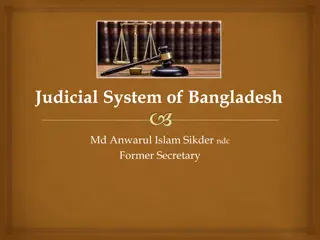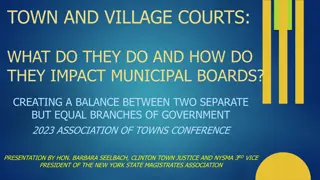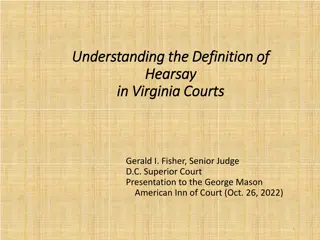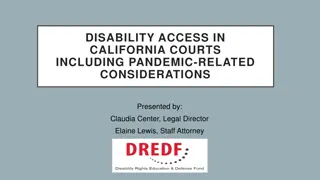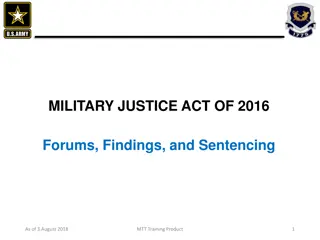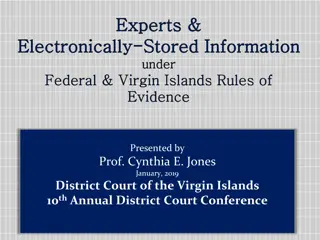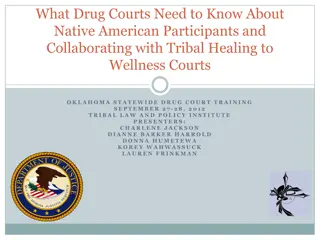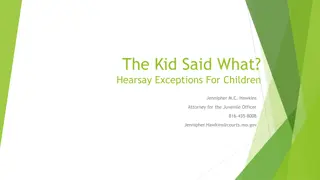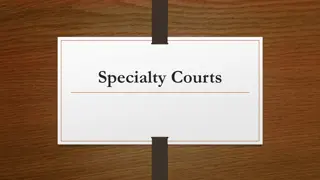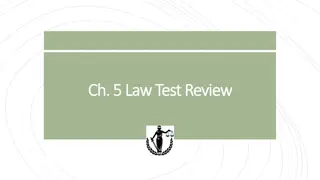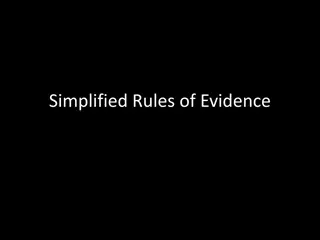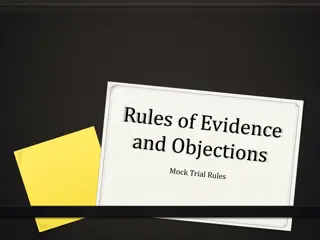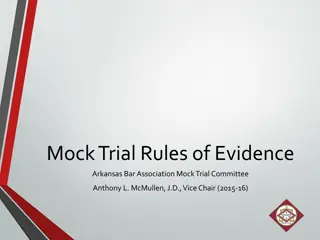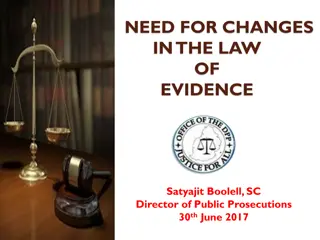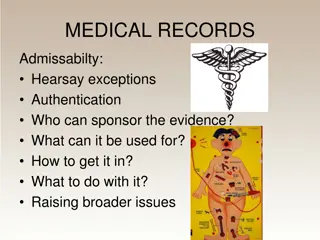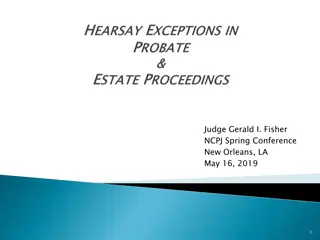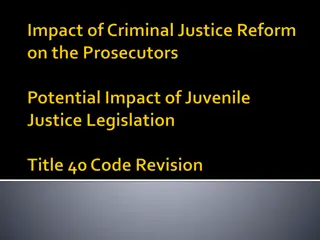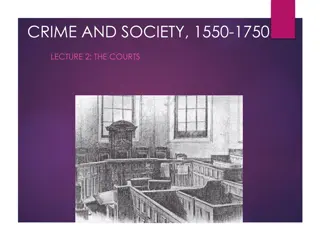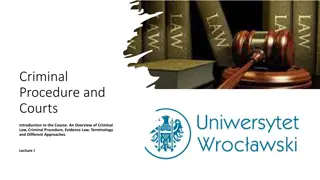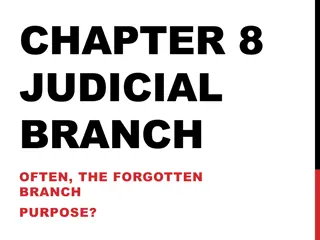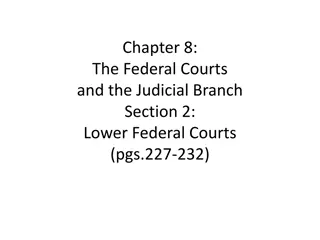Understanding Hearsay in Virginia Courts - Key Principles and Rules
Virginia's rules of evidence, particularly regarding hearsay, have specific principles and rules that guide the admissibility of evidence in various trial settings. The presentation by Judge Gerald I. Fisher sheds light on how the court determines the admissibility of evidence, including considerations for hearsay statements. Additionally, the discussion highlights reasons why the law generally views hearsay with distrust due to factors like witness demeanor, lack of cross-examination, and concerns about sincerity. Understanding these aspects is crucial for legal practitioners and individuals involved in court proceedings in Virginia.
- Virginia Courts
- Hearsay Rules
- Virginia Rules of Evidence
- Trial Judge Considerations
- Legal Principles
Download Presentation

Please find below an Image/Link to download the presentation.
The content on the website is provided AS IS for your information and personal use only. It may not be sold, licensed, or shared on other websites without obtaining consent from the author. Download presentation by click this link. If you encounter any issues during the download, it is possible that the publisher has removed the file from their server.
E N D
Presentation Transcript
Understanding the Understanding the Definition of Hearsay Hearsay in Virginia Courts in Virginia Courts Definition of Gerald I. Fisher, Senior Judge D.C. Superior Court Presentation to the George Mason American Inn of Court (Oct. 26, 2022) 1
Preliminary Principles 1. The Virginia Rules of Evidence became effective July 1, 2012. [A]dopted to implement established principles under the common law and not to change any established case law rendered prior to the adoption of the Rules. Rule 2:102. Rejected adoption of the Federal Rules of Evidence 2. The Rules, including the rules relating to hearsay, apply in both jury and non-jury trials, in preliminary hearings, in non-summary contempt cases, and in juvenile and domestic relations cases, but not in small claims cases. Rule 2:1101. 2
3. The rules relating to hearsay apply when the witness is also the declarant i.e., a witness may not testify to his/her own hearsay statements unless they fall within exceptions to the bar against hearsay 4. WORDS, ISSUES & CONTEXT MATTER! 3
What Information Can a Trial Judge Consider When What Information Can a Trial Judge Consider When Determining Whether Evidence is Admissible? Determining Whether Evidence is Admissible? Fed. R. Evid. 104(a) provides that the court decides the admissibility of evidence, and when doing so, is not bound by evidence rules, except those on privilege. This means the court may consider otherwise inadmissible non- privileged evidence, including hearsay. Va. Rule 2:104(a) is not as explicit but appears to operate the same way. 4
Rule 2:802 HEARSAY RULE Rules, other Rules of the Supreme Court of Virginia, or by Virginia statutes or case law. Hearsay is not admissible except as provided by these 5
Why Does the Law Distrust Hearsay? Why Does the Law Distrust Hearsay? 1. Jury/Judge cannot see demeanor of witness 2. Inability to test the declarant s perception, memory, or narration. 3. Statement usually not made under oath 4. No ability to cross-examine/confront 5. Concerns about motivation, sincerity of statement (i.e., fraud or perjury) 6
What is Hearsay? Rule 2:801 DEFINITIONS The following definitions apply under this article: ***** made by the declarant while testifying at the trial or hearing, offered in evidence to prove the truth of the matter asserted. (c) Hearsay. Hearsay is a statement, other than one 7
Fed. R. Evid. 801. Definitions. * * * * * (c) Hearsay. Hearsay means a prior statement one the declarant does not make while testifying at the current trial or hearing that a party offers in evidence to prove the truth of the matter asserted by the declarant. 8
Essential Terms Essential Terms witness one who testifies in court about an out-of-court statement testimony what a witness says in court declarant person who makes an out-of-court statement A person can be both a declarant and a witness if s/he testifies about statements they made out-of-court. statement (1) an oral or written assertion or (2) nonverbal conduct of a person, if it is intended as an assertion. Rule 2:801(a). 9
Under this definition, a statement may be in any one of the following forms: 1. Oral statement 2. Written statement 3. Conduct 4. Silence 10
Hypothetical #1 Wife is charged with the murder of Husband. At trial, the Commonwealth calls Police Officer who will testify that when the police arrived at the couple s home, Husband was lying on the floor dead from a bullet wound to the heart. Right next to him was his beloved parrot Squawker, who was saying over and over, Doris, why are you pointing that gun at me? Please don t point the gun at me! Defense counsel objects to the evidence as hearsay. Is this hearsay? 11
Questions to Ask When Analyzing Hearsay Questions to Ask When Analyzing Hearsay 1. Was the statement/communication made out of court, i.e.,outside of the current proceedings? 2. Does the statement/communication that was made contain an assertion? 3. Is it offered to prove the truth of the assertion or, instead, offered for some other relevant purpose? 4. If it is being offered for its truth, does it satisfy an exception to the bar against hearsay? 13
First Question: Was the Statement Made Out-of-Court ? Whenever a witness testifies to words that were spoken by anyone (including himself/herself) other than during the trial/hearing currently being held, those words are an out-of- court statement for the purposes of Rule 2:801(c). 14
Second Question: Does the Statement (i.e., the Words, Conduct, or Silence) Contain an Assertion? Rule 2:801. Definitions. (a) Statement. A statement is (1) an oral or written assertion or (2) nonverbal conduct of a person, if it is intended as an assertion. Accord Fed. R. Evid. 801(a). 15
What is an Assertion? What is an Assertion? An assertion is a communication (oral, written, conduct or silence) by the declarant containing facts or beliefs that the declarant seeks to be accepted as true. 16
Examples 1. To determine whether it is raining, you look out the window and Notice that several people are walking around with open umbrellas over their heads Not an Assertion. Call out to someone you know on the street and ask if it s raining, and that person moves the umbrella up and down Assertion (by conduct). 2. To determine whether a light had changed to green Cars that were stopped at the light start moving Not an Assertion. The car closest to the light doesn t do anything and the car behind him honks and the first car starts moving forward Assertion (by conduct) by the driver of the second car (and, arguably, by the driver of the front car). 17
Hypothetical #2 In a will contest, the testator s heir challenges the will, which left part of the testator s estate to his servant. The heir claims that the testator lacked capacity/competence when he made the will. In response, the servant seeks to introduce letters written by friends to the testator during the time when he made the will, where the letters are written in a manner that suggests the writers believed the testator to be of sound mind. The heir objects to the letters as hearsay. Is this an assertion (and hence hearsay)? 18
Hypothetical #3 The next day, the police go to defendant s home and ask his wife to give them the clothes her husband was wearing the previous night. Wife says nothing but leaves the room and returns a few minutes later with a sweater that she gives to the police and that is later found to contain blood on it that matches the victim s rare blood type. The Commonwealth seeks to introduce this evidence at trial, but defense counsel objects that it is hearsay. Is this an assertion (and hence hearsay)? Defendant is charged with murder of a hotel manager. 19
Hypothetical #4 Hypothetical #4 Defendant is charged with sexual assault. His defense is consent and he claims that he and the Complainant knew each other and had agreed to an exchange of sexual favors for drugs. During the Commonwealth s case-in-chief, Complainant testifies that she did not know Defendant. to testify that when Defendant was arrested, he asked the officer, Does Peggy (Complainant s first name) know I am here? The Commonwealth objects that Defendant s question is hearsay. Is Defendant s question an assertion (and thus hearsay)? In the defense case, Defendant calls the arresting officer 20
Hypothetical #5 In a murder prosecution, Witness testifies that he drove Victim to meet two persons whom Witness did not know. After the car stopped, two men approached the passenger side of the car and began talking to Victim. Victim calls one of the men Tony, and the other man, Leroy, asks for cocaine. After a dispute, Victim gets shot and killed. Other evidence demonstrates that Defendant s name is Tony. Defendant objects to Witness s testimony about Victim s statement of Tony as hearsay. Is this an assertion (and thus hearsay)? 21
Whose Burden is it to Show That the Statement is an Assertion? Although it is the burden of the proponent of evidence to establish the criteria for its admission, when addressing purported hearsay, it is the party challenging admission of the declaration that bears the burden of demonstrating the declarant s requisite intent. United States v. Summers, 414 F.3d 1287, 1300 (10th Cir. 2005); see also Adv. Comm. Note, Fed. R. Evid. 801(a) ( When evidence of conduct is offered on the theory that it is not a statement, and hence not hearsay, . . . [t]he rule is so worded as to place the burden upon the party claiming that the intention existed; ambiguous and doubtful cases will be resolved against him and in favor of admissibility. ). 22
Silence as an Assertion Silence cannot be considered an assertion unless one concludes that by remaining silent the declarant intended to assert something. Silence is usually ambiguous. The FRE Advisory Committee has indicated that ambiguous cases are resolved in favor of concluding that there was not an assertion (thus no hearsay): The rule is so worded as to place the burden upon the party claiming that the intention existed; ambiguous and doubtful cases will be resolved against him in favor of [classifying the conduct as non- assertive and therefore non-hearsay]. Adv. Comm. Note, Fed. R. Evid. 801(c). 23
Hypothetical #6 Plaintiff sues for injuries he suffered because the railway car in which he rode was allegedly too cold. Defendant Railroad wants to call the porter to show that other passengers did not complain, thereby indicating that the car was not too cold. Plaintiff objects to the proposed testimony as hearsay. Is this an assertion (and thus hearsay)? 24
Hypothetical #7 What if, instead, the porter asked if anyone else thought that the car was cold, please raise your hand, and no one raised his/her hand? Is this an assertion (and thus hearsay)? 25
Questions & Directives as Assertions Questions usually are intended to acquire information, not to impart it, so questions usually are not characterized as intentional assertions and hence are not hearsay. Directives also do not normally convey information for the purpose of having it accepted as true. 1. But that is not invariably so. Sometimes questions or directives do contain explicit assertions of fact or, in the language or tone used, are intended as assertions and not as genuine requests for information. 2. Thus, the issue concerning questions and directives oftentimes is whether the declarant is actually asking a question, i.e., seeking information or making a request or, instead, intending to assert a fact the court must determine the declarant s actual intent. 26
In either circumstance, it is the party challenging admission of the declaration that bears the burden of demonstrating the declarant s requisite intent, and ambiguous and doubtful cases should be resolved in favor of the statement not being an assertion and therefore not hearsay. 27
Hypothetical #8 Defendant is charged with various firearms and narcotics charges after a police search of the apartment in which he was arrested. While officers were searching the apartment, a telephone rang, and police answered it. The unidentified caller first asked to speak with Keith [Defendant s name] and then asked whether Keith still had any stuff? When asked as to the meaning of this question, the caller responded by indicating a quantity of crack cocaine. Defendant objects, arguing that the hearsay statement asserted that he was involved in drug distribution. Is this an assertion (and thus hearsay)? 28
Hypothetical #9 prosecution seeks to introduce the statement of Codefendant made during his apprehension by police, which occurred shortly after the robbery. As he was being walked to the squad car, Codefendant stated, How did you guys find us so fast? Defendant objects to the statement as hearsay. [Assume there is no Confrontation Clause objection.] Is this an assertion (and thus hearsay)? Defendant is prosecuted for bank robbery. At trial, the 29
Hypothetical #10 father s will, which disinherits him and makes Brother #2 the sole beneficiary. Brother #1 claims that the will is a forgery and/or the product of undue influence by Brother #2. Brother #1 wishes to introduce into evidence testimony from Sister that she was arguing with Brother #2 and angrily asked him, Did Brother #1 ever steal money from Dad? Is this an assertion (and thus hearsay)? In an estate dispute, Brother #1 is challenging his 30
This, ladies and gentlemen, is Exhibit A, the sneakers that urged my client to Just Do It. (Not an assertion) 31
Definition of Assertion Recap Hearsay is a statement (oral, written, conduct, silence) if it is intended by the declarant as an assertion. An assertion is a positive declaration and, generally, not an implied assertion. But see Brown v. Commonwealth, supra. With respect to each statement , the critical issue is analyzed from the point of view of the declarant, i.e., did the declarant intend to communicate a fact with the expectation that the fact will be accepted as true. 32
Third Question: Is the Statement Offered for the Truth of the Matter Asserted? Hearsay is a statement . . . offered in evidence to prove the truth of the matter asserted. Rule 2:801(c) For each statement you have to ask: Is the party trying to prove the truth of the out-of-court statement or conduct or, instead, trying to prove that the statement or conduct occurred, and that the occurrence is relevant to an issue in the case? If the statement is not offered to prove the truth of the matter asserted in the statement, then it is not hearsay. 33
Assertions Not Being Used For Their Truth Verbal Acts (or Legally Operative Acts) a new legal relationship by itself or when uttered with a particular intent. It is not considered an assertion and, hence, is not hearsay. It is not offered for what it says, but for what it does. Park, Orenstein & Nance, Evidence Law, A Student s Guide to the Law of Evidence as Applied in American Trials (5th ed. 2022) 14.04; see also McCormick on Evidence, Hornbook Series, Student Edition (8TH ed. 2020) 249. Legally operative language is language that establishes The effect [of the definition contained in Fed. R. Evid. 801(c)] is to exclude from hearsay the entire category of verbal acts and verbal parts of acts in which the statement itself affects the legal rights of parties or is a circumstance bearing on conduct affecting their rights. Adv. Comm. Note, Fed. R. Evid. 801(c) 34
E.g., marriage vows; statements of donative intent accompanying a gift; statements of guaranty; words of offer or acceptance of a contract; words of slander or libel. 35
Hypothetical #11 In an estate dispute, decedent Mother s children seek return of a valuable necklace that Mother s Niece has and which she claims was a gift from Mother. At trial, Niece testifies that on the day before her 18th birthday Mother gave her a wrapped box and said, This is a birthday present from me. Don t open it until tomorrow When Niece opened the box the next day, the necklace was inside. She immediately called Mother to thank her, and Mother said, Enjoy it. I was glad to give it to you. Mother s children object to the testimony as hearsay. Are the statements hearsay? 36
Other Primary Situations Where the Statement is Not Offered for its Truth Mental state of the party (a) were actions willful (b) malicious (c) with intent to defraud (d) with intent to murder, etc. To show the effect on the hearer such as duress, self- defense. To show knowledge or proof of notice. To show the state of mind of the declarant. Use of prior inconsistent and consistent statements to challenge or bolster credibility. Rule 2:801(d); Tackett v. Commonwealth, 2008 Va. App. LEXIS 535 37
Hypothetical #12 Husband and Wife, who are both in their second marriage, are involved in an automobile accident and both die. Who died first will determine the distribution of their joint estate. At the estate trial, Husband s executor seeks to introduce the testimony of Police Officer, who was the first person to arrive on the scene, to testify that when he arrived, he asked, Is everybody okay? and Husband responded, I am alive. Wife said nothing, and when Police Officer checked for her pulse, he could not detect one. Moments later, he checked on Husband, but he, too, had no pulse. this hearsay? Wife s executor objects to the testimony as hearsay. Is 38
Hypothetical #13 distribute drugs from an apartment. The prosecution seeks to introduce as evidence pay/owe sheets (documenting drug transactions, in code) found in the apartment when a search warrant was executed. Defense objects. Is this hearsay? Defendant is charged with possession with intent to 39
Hypothetical #14 In a prosecution for attempted capital murder of a police officer where Defendant shot at an unmarked police car that had stopped him in order to arrest him on drug charges, Defendant, in support of his defense of self-defense, seeks to introduce into evidence statements by Defendant s girlfriend s former boyfriend that he would kill Defendant the next time he saw him. Commonwealth objects as hearsay. Is this hearsay? 40
Hypothetical #15 In murder prosecution where Defendant was found in possession of rings belonging to the Decedent and claimed he had them before the murder, the Commonwealth seeks to introduce Decedent s statement to her sister the day before the murder, that she wanted the sister to take her rings to be repaired the next time she visited. Defendant objects to the testimony as hearsay. Is this hearsay? 41
Hypothetical #16 In a bench trial where the defendant was charged with robbery, carjacking and related offenses, the Commonwealth seeks to introduce Police Officer #1 s testimony that another officer (Police Officer #2) stopped and detained Defendant approximately two blocks away from the location where the stolen car was stopped by the police and four men ran from the car, after Police Officer #2 saw Defendant emerge from a backyard, out of breath and wearing dirty black clothes. Defendant objects to the testimony as hearsay. Is this hearsay? 42
Hypothetical #17 Defendant is charged with the murder of his Girlfriend. In the defense case, Defendant testifies that he invited Girlfriend over to view his gun collection and was showing Girlfriend a new gun he had purchased and it accidentally discharged, killing her. In its rebuttal case, the Commonwealth calls Girlfriend s Best Friend, who testifies that a few days before the shooting Girlfriend told her (Best Friend) that Defendant had threatened to kill her if she ever left him and that she was afraid of him. Defendant objects to the statements as hearsay. The ACA asserts they are not being used for their truth. Are the statements hearsay? 43
Hypothetical #18 Defendant is charged with the murder of his roommate. Defendant testifies that he did not kill roommate, that they were on good terms, that he left their home while roommate and another individual were involved in a heated argument, and he discovered roommate s body when he returned home. In its rebuttal case, the Commonwealth calls two witnesses to testify that, in the weeks and months preceding Roommate s murder, Roommate had told them several times that he was dissatisfied with Defendant because he wasn t contributing his share of the household expenses and he was going to ask Defendant to move out. Trial judge overrules Defendant s hearsay objection and instructs the jury they could not use the statements to conclude Defendant owed Roommate a debt or had not paid his expenses. Although it did not so instruct the jury, the trial court also ruled that the evidence could be used to determine Roommate s state of mind. Are the statements hearsay? 44
Hypothetical #19 Defendant is prosecuted for the murder of his girlfriend, with whom he was living. In its case-in-chief, the Commonwealth presented evidence that Defendant shot Girlfriend after she came home and told him she had been with her lover. In the defense case, Defendant testifies that he was trying to pull his gun out of a shoulder holster that he was wearing wrongly, when the gun accidentally discharged, killing Girlfriend. Defendant also testified that his relationship with Girlfriend was fabulous. In its rebuttal case, the Commonwealth calls (1) a friend of Girlfriend to testify that a few months before the shooting Girlfriend had told him that Defendant had threatened to kill her if she left him and (2) Girlfriend s lover to testify that on the day of the shooting Girlfriend told her that she wanted to leave Defendant. The defense objects that both statements are hearsay. Are the statements hearsay? 45
Principle: Whenever a party claims that it is not using a hearsay statement for its truth, particularly when the statement is being used to prove the declarant s state of mind, the court must ask whether the non-hearsay purpose is relevant and if it is, whether the evidence contained in the statement is probative of that purpose and can be properly used for that purpose and not for its truth. If the purpose is not relevant or if the statement is not probative of the purpose, it is hearsay. 46
Differences Between Rule 2:801(d) and FRE 801(d) 1. In Virginia, prior inconsistent statements made by a witness, even if made under oath, can only be used for impeachment. In federal court, prior inconsistent statements made by a witness under oath at a prior proceeding or deposition are substantive evidence. 2. In Virginia, prior consistent statements can only be used to bolster credibility and only if the witness has been impeached (i) by means of a prior inconsistent statement or (ii) as having an improper influence or motive to testify falsely or by an express or implied charge that the in-court testimony is a recent fabrication, and the prior statement must have been made before the improper motive. In federal court, prior consistent statements that meet these criteria are substantive evidence. 3. In Virginia, prior identifications are hearsay. In federal court, prior identifications, even if denied by the witness at trial, are substantive evidence. 47
Va. Rule 2:801(d) (d) Prior statements. When a party or non-party witness testifies . . ., a prior statement (whether under oath or not) is hearsay if offered in evidence to prove the truth of the matters it asserts, . . . (1) Prior inconsistent statements. A prior statement that is inconsistent with the hearing testimony of the witness is admissible for impeachment . . . (2) Prior consistent statements. A prior statement that is consistent with the hearing testimony of the witness is admissible for purposes of rehabilitating the witness's credibility, but only if A. the witness has been impeached using a prior inconsistent statement . . ., or B. (i) the witness has been impeached based on alleged improper influence, or a motive to falsify testimony, such as bias, interest, corruption or relationship to a party or a cause, or by an express or implied charge that the in-court testimony is a recent fabrication; and (ii) the proponent of the prior statement shows that it was made before any litigation motive arose for the witness to make a false statement. 48
Fed. R. Evid. 801(d) (d) Statements That Are Not Hearsay. A statement that meets the following conditions is not hearsay: (1) A Declarant-Witness s Prior Statement. The declarant testifies and is subject to cross-examination about the prior statement, and the statement: (A) is inconsistentwith the declarant s testimony and was given under penalty of perjury at a trial, hearing, or other proceeding or in a deposition; (B) is consistentwith the declarant s testimony and is offered (i) to rebut an express or implied charge that the declarant recently fabricated it or acted from a recent improper influence or motive in so testifying; or (ii) to rehabilitate the declarant s credibility as a witness when attacked on another ground. (C) identifies a person as someone the declarant perceived earlier. 49
Hypothetical #20 Driver #1 and Driver #2/Defendant were involved in an automobile accident. Shortly after, but unrelated to, the accident, Driver #1 died. His estate then sued Driver #2. At a pretrial deposition, Witness testified that Driver #2/Defendant was at fault because he ran a red light. At trial, however, Witness testifies that the light was yellow when Driver #2/Defendant went through it. Counsel for Plaintiff estate then impeaches Witness with his sworn deposition testimony. At the end of Plaintiff s case, defense counsel moves for a directed verdict, arguing that there is no evidence to support Plaintiff s claim of Defendant s negligence. Plaintiff s counsel disagrees, asserting that Witness s sworn deposition provides sufficient evidence to overcome a motion for directed verdict. denied? Should the motion for directed verdict be granted or 50


